Note: All pictures are from a prototype version of the game, and is not indicative of the final quality of the product. Also, I am terrible at cutting things, to explain the extra paper around, well, all of my pieces…
Fresh from their successful Kickstarter of Micro Play-Break: Castles, the folks at MSP Games have designed another game, Micro Play-Break: Kingdoms! I had the fortune of receiving a prototype version of the game this week to go along with my review of Castles, and I wanted to share my thoughts with all of you. You can find the Kickstarter here – after reading, learn more about the game directly from the source!
Similarly to Castles, Kingdoms is an ultra-portable game that can easily fit in your purse or wallet. Although I didn’t directly test it like I did for Castles, the dimensions of the game are similar enough that I can say with certainty that it’ll work. The first thing about Kingdoms that caught my eye was the board. Unlike with Castles, the board for Kingdoms is necessary to play, due to its less-abstract nature. The board is divided into three concentric sections – forested regions on the outskirts of the board that are limited to one of the two players, plains on the inside where the game starts, and swampland in the center of the map (more on the swamps later). The artwork on the map itself is nicely drawn – if it weren’t needed for play, it could possibly make for a nice piece to put on the wall. It definitely attracted the attention of people while I was preparing the prototype for play!
Each player has eight double-sided tokens. On one side is a knight; the other, a fort. These pieces serve dual purposes. When on the board, they serve unique jobs (the knight is used to eliminate enemy knights, the forts are used to defend positions and get actions back). However, any pieces not on the board or out of the game are tossed at the start of your turn, and your actions determined by how they land. Even without understanding what the different sides/actions are, it is evident that a balance must be struck between having pieces in play and holding pieces to get additional actions.
As actions, Knight and Fort icons have different actions, but only one action type can be chosen per turn (one knight action type, one fort action type). A knight action, for instance, can be used to either play additional knights on the board (adjacent to one of your pieces), or to move a knight piece. Since you can only do one or the other, it means that playing and moving a knight piece cannot be done on the same turn.
Knights are key to winning the game – following Othello-style rules, if you can sandwich enemy knights between your own knights, you permanently remove those cards from the game, limiting your opponents options. Also, moving knights to a specific location is a victory condition, so effective knight placement and movement will make or break a match of Kingdoms.
Fort actions, however, are a bit more subtle in their usefulness. With a fort action, you can flip a knight over, turning it into a fort card. Fort cards are not removable by knights, so this is a way to protect your assets from being removed. Fort actions can also be used to return forts to the action pile, giving you an additional action next turn. Although the forts themselves do not directly contribute to victory, they are the only way to recover your knights for other purposes.
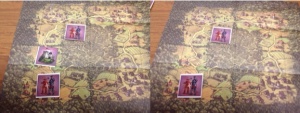
Recovering actions is a two step Fort process. First, knights are converted to forts (L). Then, the forts can be recovered as actions later in the game (R)
Just don’t build them in the swamp. As Monty Python taught us, it isn’t the best of ideas…
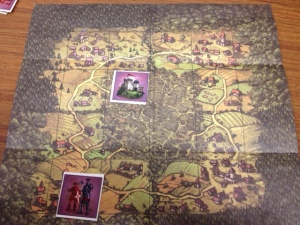
The game does not include rules for building forts on the foundation of forts lost to the swamp, for better or worse…
There are two ways to win; a player wins by Dominion if they successfully eliminate all opposing knights from the plains and swamp. The players also win by Castling if they manage to get a knight in a position where he cannot be captured (for instance, by making it to one of the opponent’s starting positions. The two win conditions seem to go hand-in-hand, making it easier to transition from one style to another based on how the game is playing out.
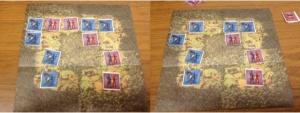
Winning by Castling – knocking the Red players knights out of position allowed for the Blue player to land a knight on one of Red’s starting spots.
When compared to Castles, Kingdoms definitely has some added complexity, and reduced the luck element somewhat. As a result, the game has a bit steeper of a learning curve (It took me a playthrough of the game to get a feel for the usefulness of each action), which could make it a bit harder to use as a gateway game with friends and family. However, I found the balance of complexity and simplicity to be quite well-done, as I was looking forward to playing another round with several other people now that I have a firmer grasp of what can and cannot be done. I personally am really looking forward to the wooden tokens in place of the card tokens. The pieces were hard to flip, and I imagine that the real pieces will still be somewhat difficult to flip. The wooden pieces will be much easier to handle. There is also a full wood version (board and pieces) that is available as a pledge level. Although it kinda kills the philosophy of a Micro Play-Break in my mind, it just seems pretty awesome!
Overall, I feel that Kingdoms is a step in the right direction, fitting a more strategy-based game into the portability and short-play nature of the Micro Play-Break series. Although the rules feel a bit obtuse at the start, it is easy enough to pick up that one can have a good understanding after the first game or two. Given that games only take 5-10 minutes to play, you can still fit in several rounds during your lunch break. Again, if you are interested in learning more, feel free to check out their Kickstarter or learn more about the MBP philosophy. Happy gaming!

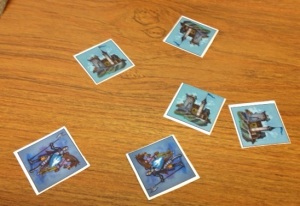

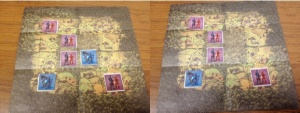
Sounds pretty intriguing! I love the various features such as short game play time and portability since I feel more games need to start moving in that direction. Excited to see what happens for this kickstarter!
I agree with you 100% on that, Nicole! I’ve been finding myself moving towards quick, portable games over the past few months. There’s times for big games like Firefly: the Board Game or Dominion, but having games like Love Letter, Coup and the Micro Play-Break Series are better for people that don’t have the 1-3 hours to dedicate to a big game.